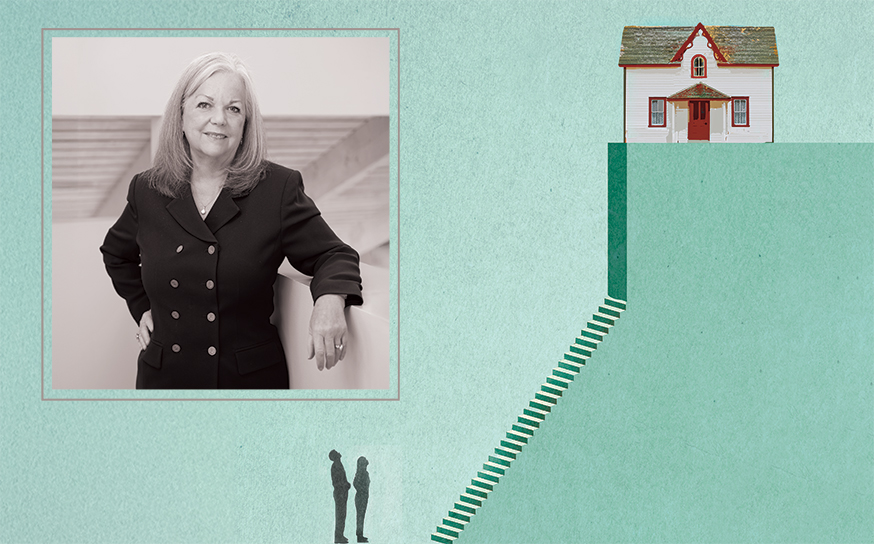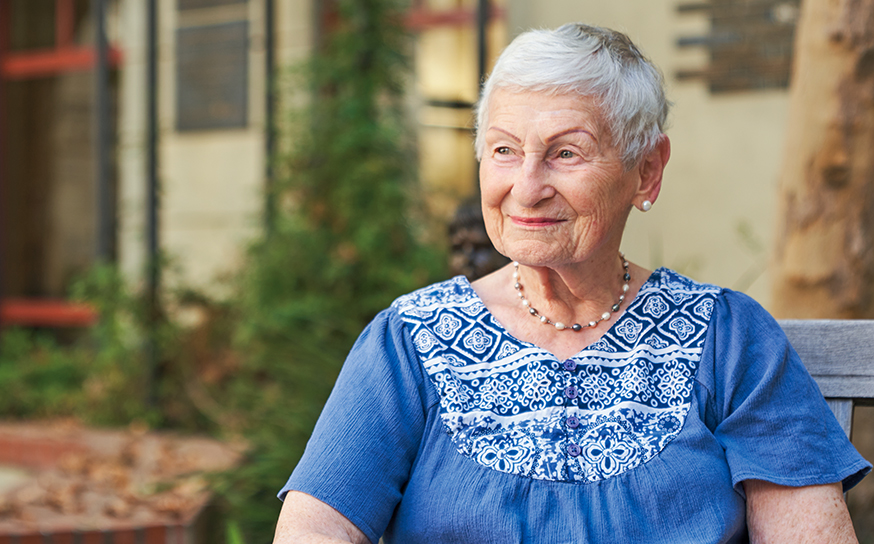On the first day of February at The Buckley School in Sherman Oaks, celebration was in the air. Just two days away from a gala event celebrating its 85th anniversary, preparations were well underway. Then everything changed.
“I received a text from a colleague at around 9:30 a.m. saying that one of our students had died and to come to the front office,” explains school counselor Mara Tapia.
An eighth grade student, Elliot, had taken his own life. He was just four days shy of his 14th birthday. He did not leave a note.
“We were all devastated and in shock,” recalls Tapia. “We’re a small school; Elliot wasn’t on anyone’s radar as having any kind of issues.”
Sally Sacon, Buckley’s Director of Communications, had been Elliot’s advisor when he was in seventh grade. She was stunned, remembering his kind smile, sense of humor, and strong relationship with family and friends.
The teen’s own family concurs: the tragedy came out of the blue. “We essentially had no warning signs,” says Elliot’s father, in a poignant phone conversation six weeks following his son’s death. “He had a normal teen life, lots of friends, was on the varsity soccer team, did well in school and didn’t seem to pressure himself.” For Buckley, it was a first. School officials say they’ve never had a student die by suicide. However across the nation, the numbers tell a different story, with teen suicide emerging as a major public health issue.
A 2016 study by the Center for Disease Control and Prevention (CDC) reveals teen suicide has doubled since 2007. It is the third leading cause of death for the ages of 10 to 14 and the second leading cause for ages 15 to 24.
In the immediate after hours, the school administration moved quickly. With a student body that includes kindergarteners, they desperately needed to get in front of the story. “We knew we had to get ahead of social media and communicate the news to parents and students at the same time,” says Sacon.
Head of School, James Busby, elaborates, “Our most important consideration was the students. We wanted them to encounter this very big life event with as much support as possible but with honest messages and developmental appropriateness because we are a K through 12 school.”
“Watching them together, I have to say, has been incredibly sweet and poignant—even in their saddest moments, they’ve been able to lean on each other, to process and wonder, to laugh and cry together. In many ways, I think they’ve been able to comfort one another in ways that adults couldn’t.” —Gregg Sacon
School officials immediately learned two critical safe messaging points: one, not to fly the flag at half-mast, as that kind of attention could lead to a “contagion effect;” and two, never use the term “committed suicide,” as that implies a crime. The “correct” or better way to put it is “died (or death) by suicide.”
Busby quickly sent an email to parents that an eighth grade student “passed away during the night unexpectedly.” It would be the first in a series of emails over two weeks that would keep the school community informed about plans and counseling resources.
Tapia coordinated the effort to break the news to each grade. Students who had previously experienced tragic deaths were pulled out of class and individually told, so that their reactions could be gauged.
It was Tapia, a licensed, clinical social worker, who was given the responsibility to inform Elliot’s fellow eighth graders.
Closing her eyes to recall that moment, Tapia takes a deep breath. “We weren’t initially able to tell the students how he died because we didn’t have permission … I prefaced by saying that Buckley is a very close-knit community, like a family, and we experience lots of different things, and this time I was there to let them know that one of their friends had died.” Minutes later the school was given permission to disclose that Elliot had died by suicide.
Tapia describes how the adults in the room sat in groups with the students, who were exhibiting a range of reactions and emotions. “We were there to talk, to hug or just sit silently with them.”
Meanwhile, Lisa Turchan, Buckley’s CFO, emailed colleagues at nearby private schools with the news.
“The response was instantaneous and overwhelming. Every school was willing to help in any way,” says Turchan. “They sent letters to their parents with tools to help them deal with the tragedy as well.”
Flowers and cards came flowing in for Buckley’s faculty and staff.
The Oaks School, where Elliot attended K-6 grade, immediately reached out to his family to provide meals, and The Buckley School sent lunch to The Oaks faculty.
The gala was postponed, and homework was put on hold for over a week.
Psychologists and counselors from over a dozen private schools immediately called to see how they could help.
“I met with 10th, 11th, and 12th graders and facilitated conversations to help process their feelings,” explains Michelle Bracken, a counselor at Harvard-Westlake.
“The discussions took different paths, as each student was dealing with the loss differently.”
Dr. Lee Herzog, a psychologist from Brentwood School, met with students as well as a group of elementary school parents, who discussed the “trials and tribulations that this parent body faces regarding how to talk, process and think with their young children about the suicide.” He adds, “I felt it was a special day to connect with this community because we are all facing these potential issues.”
Curtis School also reached out, providing breakfast for the Buckley faculty in the first few days. “We wanted to do something to help the staff as well as the students,” says school psychologist Dr. Kavita Ajmere, who spent two of the initial days at Buckley, meeting with students to help them process their feelings.
And support came from other sources as well. Buckley’s insurance company, United Educators, sent dedicated crisis and grief counselors the next day and over the following two weeks, providing a total of 300 counseling hours for students, parents and staff.
 Teen Line, a hotline and outreach program affiliated with Cedars-Sinai Medical Center, sent more than a dozen trained adult facilitators to meet with students and also to present a professional development workshop on teen suicide.
Teen Line, a hotline and outreach program affiliated with Cedars-Sinai Medical Center, sent more than a dozen trained adult facilitators to meet with students and also to present a professional development workshop on teen suicide.
“After the first day, we were able to have enough counselors here for our students to meet individually or in small groups. Our campus was turned into a grief-counseling center for students (as well as staff and parents), with rooms set aside for the purpose,” says Turchan.
Lauren Schneider, Clinical Director of Child & Adolescent Programs at Our House, a Los Angeles-based grief support and education center, arrived with counselors on the Monday following the tragedy to meet with Elliot’s core friend group; the friends of Elliot’s older brother (who also attends Buckley); and to lead a parent/guardian information session.
Sally Sacon’s husband, Gregg Sacon, the Assistant Head of Middle School and a math teacher, says he spent a great deal of time with Elliot’s friends in the days and weeks following the suicide.
“Watching them together, I have to say, has been incredibly sweet and poignant—even in their saddest moments, they’ve been able to lean on each other, to process and wonder, to laugh and cry together. In many ways, I think they’ve been able to comfort one another in ways that adults couldn’t.”
“For a teenager, a relationship to a peer is equal or more important than family. Their relationships and identity to peers is crucial for preparing themselves for their future in terms of adulthood,” Schneider adds. “When a best friend dies, it’s a serious loss that influences them for the rest of their lives. For these children, you don’t want the loss of their best friend to be the story of their lives. We worked with Elliot’s friends to learn how to express their grief and discuss what they could do to honor their friend.”
Elliot’s closest friends organized a remembrance service at Buckley and invited the entire community. Attendees included parents and students from every division, as well as Elliot’s family—two sets of parents, brother, eight grandparents and a handful of cousins. Counselors attended to help students who were struggling.
“Elliot was a good friend to his friends. At the memorial, his friends got up and spoke about how caring, kind and funny he was … and that he was always there when they needed him, and they only wish that they could have been there for him,” recalls his father.
At an evening meeting conducted by Schneider and the counselors from Our House, parents were trying to make sense of what had happened. In Elliot’s case, there were no typical signs; he was not bullied or academically stressed and did not appear depressed.
“When a best friend dies, it’s a serious loss that influences them for the rest of their lives. For these children, you don’t want the loss of their best friend to be the story of their lives.” —Lauren Schneider
“Ninety percent of people who end their lives meet criteria for major depression—which is considered a ‘disease of the brain,’” states Schneider. “On the other hand, ‘episodic depression’ can come on suddenly. Most children are resilient, but some are more delicate and succumb to the pressures of a depressive episode that results in a suicide.” She is quick to point out that in Elliot’s case, no one will probably ever know the motivation behind his actions.
Cheryl Eskin, Teen Line program director, adds, “Sometimes teens don’t want us to know they are struggling or are very good at hiding it, which is hard and scary.
It’s important for parents to talk about tough subjects early and often and make sure kids have a trusted adult or outlet, even if it’s not the parent.”
She further explains that teens can also be impulsive and not always think through the consequences of their actions. “A lot of teens haven’t developed coping skills or ways to deal when things don’t go their way; it’s important as parents to teach our kids these skills and not to rush in to fix every little problem.”
She notes that parents should monitor and set limits for a child’s cell phone and social media usage, so it is not their only “social” interaction. And in turn, “Parents should also monitor their own use, so they can role model and talk about how what you see online isn’t always reality,” stresses Eskin. She also advises not letting kids sleep with phones in their rooms at night.
Calabasas-based psychotherapist Stacy Kaiser emphasizes that open communication is key with all children. She recommends encouraging them to start conversations when they are in a relaxed state, perhaps on a car ride or over dinner—rather than when they have just walked in the door. Talk to them about their friends and what they might be hearing and seeing, making sure to note any changes in behavior.
Busby has set plans in motion to integrate suicide prevention within the parent education curriculum, and to introduce peer awareness training and mentoring into the affective (non-academic) curriculum.
As part of the healing process, Buckley’s newspaper, The Student Voice, included a special color insert with loving tributes and these words in bold print: “Elliot is fondly remembered as a son, a brother, a friend and a member of the Buckley community.”
Speaking for Elliot’s entire family, his father praised the respect given his son. “We’ve been embraced in a way we haven’t seen before and couldn’t imagine. We received loving, caring messages, that are uncommonly generous and thoughtful.”
On the Front Line
When tragedy struck at her own school, Buckley School senior Taylor Shabani, a trained suicide prevention volunteer, sprang into action.
— Written by Rachel Heller Zaimont
Taylor Shabani remembers the morning she and her classmates learned the awful news. She was in the middle of AP U.S. Government when school officials asked each grade to report to separate assembly rooms. Gathered together with her fellow Buckley School 12th graders, she heard that an eighth grader had taken his life.
“The room fell silent,” recalls Taylor, 18. Once the news sunk in, “I was bawling on the floor for a good hour.”
Taylor’s reaction surprised her, since she volunteers once a week as a trained listener at Teen Line, the teen-to-teen support hotline based at Cedars-Sinai Medical Center. “I’ve been faced with listening to the worst of the worst. But until this moment, suicide was a notion, not a reality I had experience with,” she says. “All I could think in my head was, ‘He could have called and gotten help.’ I wished there was something I could have done to prevent it.”
Taylor began volunteering at Teen Line as a high school freshman. Her parents had recently divorced and despite a background she calls “privileged,” she felt as though she was thrust into maturity at a disorienting pace. “I didn’t grow up in a bubble. I knew what going through pain meant and I knew what coping meant,” she says. “I felt I could be a voice for other teens.”
Taylor underwent intensive training at Cedars, learning how to communicate safely with anguished callers and steer them toward life-saving mental health resources. She heads to the hospital every Thursday evening for a five-hour shift.
After listening, Taylor responds with a twofold mission—to make sure they are not in immediate danger and to convince them they should want to live. “I try to find the little part of them inside that wants to stay alive and encourage that part,” she explains.
In the hours after the announcement, Taylor sprang into action. She called her supervisor, Jenny Pascal, and helped coordinate a visit to Buckley from Teen Line’s outreach wing. The next day about a dozen facilitators visited the Buckley School campus, leading group discussions on how to process grief.
“Taylor is mature and responsible beyond her years,” Jenny notes. “She possesses a natural sense of compassion and empathy that shone through to all who worked with her.”
Taylor also contributed a personal touch to the healing effort. She and a friend put up posters around the Buckley campus, bearing the message “You are loved.”
“It’s okay to not be okay,” says Taylor. “There is someone who cares.”
PREVENTION HOTLINES
National Suicide Prevention Lifeline
1-800-273-8255
Crisis Text Line 741741
California Youth Crisis Line
1-800-843-5200
Teen Line at Cedars-Sinai
1-310-855-4673
Crisis Text Line 839863
teenlineonline.org
Join the Valley Community









